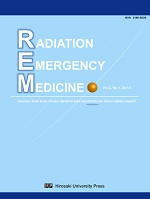Masahiro Hosoda1, Yoshinori Fukui2,3, Chanis Pornnumpa1, Atsuyuki Sorimachi4, Tetsuo Ishikawa5, Masanori Yachi6, Ayano Nara6, Hiromi Yokota1,7, Shinji Tokonami4∗
1Department of Radiological Life Sciences, Hirosaki University Graduate School of Health Sciences, Japan
2Student in the Education Program for Professionals in Radiation Emergency Medicine, Hirosaki University, Japan
3Department of Radiological Safety Management, Division of Reprocessing Business, Japan Nuclear Fuel Ltd., Japan
4Department of Radiation Physics, Institute of Radiation Emergency Medicine, Hirosaki University, Japan
5Department of Radiation Physics and Chemistry, School of Medicine, Fukushima Medical University, Japan
6Department of Radiological Technology, School of Health Sciences, Hirosaki University, Japan
7Department of Disability and Health, Hirosaki University Graduate School of Health Sciences, Japan
Radiat Emerg Med (2014) 3 (1): 59-62



